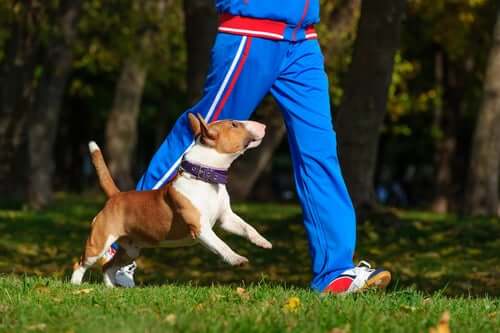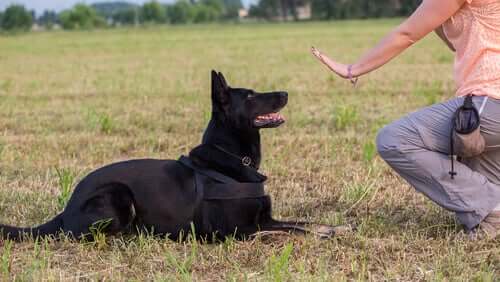This Sport for Dogs will Turn Your Pet into a Champion!

Animals should also workout in order to avoid obesity and other illnesses. Reducing anxiety and channeling their energy productively is also another benefit of good exercise. In the following article, we’ll tell you everything about this special sport for dogs that can turn your furry friend into a champion!
International dog obedience

The name of this curious sport for dogs is “International Dog Obedience”. As its name indicates, it’s based on different exercises in order to find the most obedient dog in the world. However, in these contests, breeds, sizes or ages don’t matter. As a result, it’s all about discipline, love, and lots of practice!
This sport began in Colombia almost a decade ago. Nowadays, people and their dogs practice it for fun and also professionally. The good news is that you can use these games to train your furry friend and maybe even help him turn into a champion, who knows?!
Specialized judges supervise the event itself and ensure that it meets the regulations. The rules aim to measure the skills of every participant. The contests have different modalities: Puppies participate in the promotional categories, there’s a category for young canines and one for adult dogs. The professional categories are grades 1, 2 and 4, for instance.
According to the experts, this sport focuses on perfection and precision. In this way, it seeks and evaluates harmony or symbiosis between the animal and its owner or trainer. Within the trials, food or toys can be used as an incentive or prize. However, it’s forbidden to mistreat the pet both on and off the track.
International Dog Obedience doesn’t require participants to have any special characteristics or belong to any specific breeds. This means that all dogs can participate in the contests, even the mixed breeds. Training can begin in puppies starting from two months of age.
Sport for dogs: The ultimate training
The contests are mainly composed of a circuit with ten exercises, which include:
- Stillness (staying still for a certain period)
- Object recovery
- Olfactory exercises
- Walking next to the guide without using a leash
- Movements that demand perfection (in the highest categories)
- Changes of position at a distance.
Within the promotional category, for instance, the regulation contains 6 exercises (all have a maximum score of 10 units):
1. Together without strap
The command that should be used by the guide or trainer is “fuss”. Dogs and trainers perform the exercise in a 16ft square. It starts with a normal speed course, continues with two turns to the right and then two to the left, two half turns and two stops. Things that can subtract points are gestures, any double commands, if the dog doesn’t adopt a required position or if he’s easily distracted, for instance.
2. Sitting in a group
The commands used are “Down” or “Sit”. This exercise is carried out in a group with a minimum of 3 dogs and a maximum of 6. The dogs begin seated with their trainers positioned 16 feet away from them. The judge then sets the mark to each of them after their trainers move 30 feet away. Points are deducted if the animal gets up before the command is made, barks or tries to fight with the other dogs. They also lose points if they don’t go to their trainer after the order has been given.
3. Control from a distance
The commands used are the same as in the previous exercise. The dog sits and the trainer moves 10 feet away. When the judge gives a signal, the dog must change his position and head towards the trainer. Lastly, at a new order, the dog must remain still.
4. Sitting in a group for one minute

The command is “sit”. The performance includes a minimum of 3 and maximum of 6 dogs. The guides are at a distance of 16 feet and then move away 10 more feet. However, during this time, the animal shouldn’t get up or change its position. Points are deducted for the same actions in the previous group exercise.
5. Sending the dog to a location
The commands used in this case are: “forward”, “stand”, “still” and “together”. The exercise begins with the dog in a corner 10 feet away from its trainer, in a standing position. The trainer will then give these orders to the dog and he should change his posture accordingly.
6. Sitting and laying down
Commands are “sit”, “down”, and “fuss.” The exercise is performed on a 16ft square with a cone on each corner. Subsequently, the trainer will command the dog to sit or lie down in every corner.
In conclusion, this type of dog obedience competition provides an opportunity for a dog-owner and their dog to work as a highly-tuned team. We hope you enjoyed learning about this admirable sport!
Animals should also workout in order to avoid obesity and other illnesses. Reducing anxiety and channeling their energy productively is also another benefit of good exercise. In the following article, we’ll tell you everything about this special sport for dogs that can turn your furry friend into a champion!
International dog obedience

The name of this curious sport for dogs is “International Dog Obedience”. As its name indicates, it’s based on different exercises in order to find the most obedient dog in the world. However, in these contests, breeds, sizes or ages don’t matter. As a result, it’s all about discipline, love, and lots of practice!
This sport began in Colombia almost a decade ago. Nowadays, people and their dogs practice it for fun and also professionally. The good news is that you can use these games to train your furry friend and maybe even help him turn into a champion, who knows?!
Specialized judges supervise the event itself and ensure that it meets the regulations. The rules aim to measure the skills of every participant. The contests have different modalities: Puppies participate in the promotional categories, there’s a category for young canines and one for adult dogs. The professional categories are grades 1, 2 and 4, for instance.
According to the experts, this sport focuses on perfection and precision. In this way, it seeks and evaluates harmony or symbiosis between the animal and its owner or trainer. Within the trials, food or toys can be used as an incentive or prize. However, it’s forbidden to mistreat the pet both on and off the track.
International Dog Obedience doesn’t require participants to have any special characteristics or belong to any specific breeds. This means that all dogs can participate in the contests, even the mixed breeds. Training can begin in puppies starting from two months of age.
Sport for dogs: The ultimate training
The contests are mainly composed of a circuit with ten exercises, which include:
- Stillness (staying still for a certain period)
- Object recovery
- Olfactory exercises
- Walking next to the guide without using a leash
- Movements that demand perfection (in the highest categories)
- Changes of position at a distance.
Within the promotional category, for instance, the regulation contains 6 exercises (all have a maximum score of 10 units):
1. Together without strap
The command that should be used by the guide or trainer is “fuss”. Dogs and trainers perform the exercise in a 16ft square. It starts with a normal speed course, continues with two turns to the right and then two to the left, two half turns and two stops. Things that can subtract points are gestures, any double commands, if the dog doesn’t adopt a required position or if he’s easily distracted, for instance.
2. Sitting in a group
The commands used are “Down” or “Sit”. This exercise is carried out in a group with a minimum of 3 dogs and a maximum of 6. The dogs begin seated with their trainers positioned 16 feet away from them. The judge then sets the mark to each of them after their trainers move 30 feet away. Points are deducted if the animal gets up before the command is made, barks or tries to fight with the other dogs. They also lose points if they don’t go to their trainer after the order has been given.
3. Control from a distance
The commands used are the same as in the previous exercise. The dog sits and the trainer moves 10 feet away. When the judge gives a signal, the dog must change his position and head towards the trainer. Lastly, at a new order, the dog must remain still.
4. Sitting in a group for one minute

The command is “sit”. The performance includes a minimum of 3 and maximum of 6 dogs. The guides are at a distance of 16 feet and then move away 10 more feet. However, during this time, the animal shouldn’t get up or change its position. Points are deducted for the same actions in the previous group exercise.
5. Sending the dog to a location
The commands used in this case are: “forward”, “stand”, “still” and “together”. The exercise begins with the dog in a corner 10 feet away from its trainer, in a standing position. The trainer will then give these orders to the dog and he should change his posture accordingly.
6. Sitting and laying down
Commands are “sit”, “down”, and “fuss.” The exercise is performed on a 16ft square with a cone on each corner. Subsequently, the trainer will command the dog to sit or lie down in every corner.
In conclusion, this type of dog obedience competition provides an opportunity for a dog-owner and their dog to work as a highly-tuned team. We hope you enjoyed learning about this admirable sport!
This text is provided for informational purposes only and does not replace consultation with a professional. If in doubt, consult your specialist.








